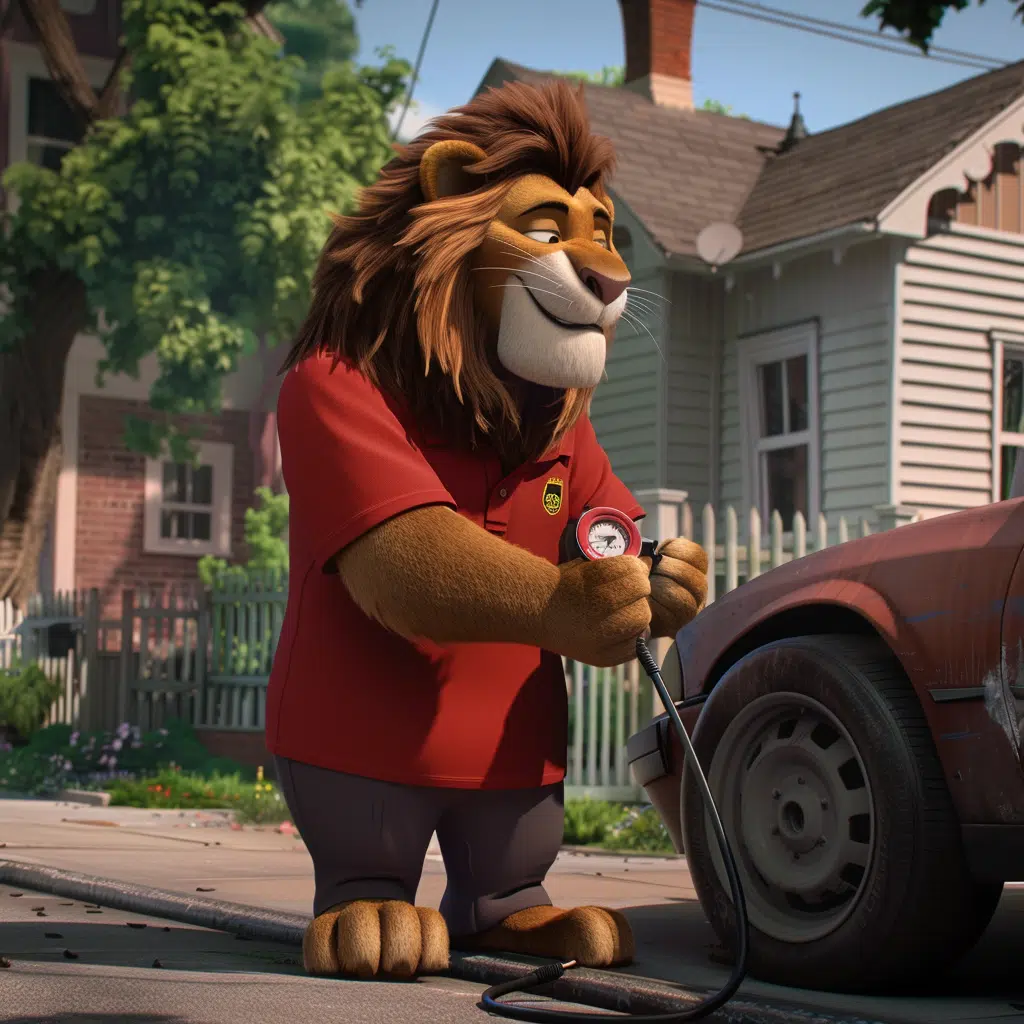Stay Safe This Summer with Leonidas’ Tire Pressure Tips!
Hi there,
Leonidas here, roaring into summer with some essential safety tips to keep you and your vehicle in top shape! As the weather heats up, it’s crucial to ensure your tires are properly inflated to avoid any mishaps on the road. Let’s dive into a step-by-step guide on how and why to check your tire pressure.

Why Tire Maintenance Matters
Maintaining your vehicle’s tire pressure is not just about comfort—it’s a crucial aspect of driving safety and performance. According to the National Highway Traffic Safety Administration (NHTSA), underinflated tires contribute to over 600 deaths and 33,000 injuries annually in the United States. Properly inflated tires ensure better handling, fuel efficiency, and longevity of your tires.
- Safety: Proper tire pressure helps maintain optimal traction and control, reducing the risk of accidents.
- Economy: Correctly inflated tires can improve your fuel efficiency by up to 3%, saving you money at the pump.
- Durability: Maintaining the right pressure prevents uneven wear, extending the life of your tires.
Summer Safety: Tire Pressure Checks
Proper tire maintenance is essential, especially during the hot summer months. Here’s a detailed step-by-step guide on how to check and maintain your tire pressure.
Step 1: Gather Your Tools
Make sure you have a reliable tire pressure gauge and your vehicle’s owner’s manual. If you don’t have your owner’s manual handy, you can usually find the recommended tire pressure on a sticker inside the driver’s door or online. Investing in a good tire pressure gauge can make a significant difference in the accuracy of your readings.
Step 2: Check Tire Pressure When Cold
For the most accurate reading, check your tire pressure when your tires are cold—either first thing in the morning or after your vehicle has been parked for at least three hours. Checking the pressure when the tires are cold ensures that the reading is not affected by the heat generated from driving.
Step 3: Measure the Pressure
Remove the valve cap from one tire and press the tire pressure gauge onto the valve stem. You should hear a hiss of air as you get the reading. Compare the reading to the recommended pressure. Ensure you check all four tires, as each one can have different pressure levels.
Step 4: Inflate or Deflate as Needed
If your tire pressure is too low, add air until you reach the recommended PSI. If it’s too high, release some air by pressing the valve stem. Recheck the pressure to ensure it’s accurate. Using a portable air compressor can be very convenient for this step.
Step 5: Repeat for All Tires
Don’t forget to check all four tires, and don’t overlook the spare tire! Keeping all tires properly inflated ensures a smoother and safer ride. A properly maintained spare tire can be a lifesaver in case of a flat.

Seasonal Tire Maintenance Tips
Each season brings unique challenges for tire maintenance. Here’s how to keep your tires in top shape year-round:
Winter:
Cold temperatures can cause tire pressure to drop, so check it more frequently. Consider using winter tires for better traction. Winter tires are designed to handle snow and ice, providing better grip and safety
Spring:
As temperatures rise, check for any damage caused by winter conditions and ensure your tires are properly inflated. Spring is also a good time to rotate your tires and check for any uneven wear.
Summer:
Heat can cause tire pressure to increase, so monitor it regularly. Make sure your tires are in good condition for long road trips. Summer is also a great time to check the tread depth and ensure your tires are ready for wet conditions.
Fall:
Prepare for wet and slippery roads by ensuring your tires have adequate tread depth and are properly inflated. Fall is also a good time to check for any damage that may have occurred during the summer.
Common Mistakes and How to Avoid Them
Many people make mistakes when checking their tire pressure, leading to inaccurate readings and potential safety hazards. Here are some common mistakes and tips to avoid them:
Mistake: Checking tire pressure when the tires are hot.
Solution: Always check tire pressure when the tires are cold to get an accurate reading.
Mistake: Using an unreliable tire pressure gauge.
Solution: Invest in a high-quality gauge and calibrate it regularly.
Mistake: Not checking the spare tire.
Solution: Always include the spare tire in your regular checks.
Mistake: Overinflating or underinflating tires.
Solution: Follow the manufacturer’s recommended PSI and avoid guessing.
FAQs about Tire Pressure and Maintenance
- Q: How often should I check my tire pressure? A: It’s recommended to check your tire pressure at least once a month and before long trips.
- Q: What should I do if my tire pressure is too high? A: Release some air by pressing the valve stem and recheck the pressure.
- Q: Can I use the same tire pressure gauge for different types of vehicles? A: Yes, but ensure the gauge is accurate and calibrated for the pressure range of each vehicle.
- Q: How can I tell if my tires are properly inflated? A: Check the tire pressure using a reliable gauge and compare it to the recommended PSI. Also, inspect the tires for even wear and no visible damage.
Environmental Impact and Sustainability
Proper tire maintenance isn’t just good for your car—it’s good for the planet. Well-maintained tires improve fuel efficiency, reducing your carbon footprint. Additionally, properly inflated tires last longer, meaning fewer tires end up in landfills. Recycling old tires and choosing eco-friendly tire options can also make a positive impact.
Spartan Junk Removal’s Tire Safety Commitment
At Spartan Junk Removal, we know the importance of tire safety firsthand. Our trucks routinely navigate the hazards of the dump, from nails to debris, and we always make sure our tire pressure is spot on. If you need help avoiding the same pitfalls, remember that we’re here to handle your junk haul for you. Let us take care of the heavy lifting and keep your vehicle safe and sound!

Conclusion
Maintaining proper tire pressure is essential for safety, performance, and cost savings. By following these tips and making tire checks a regular part of your routine, you can ensure a smoother and safer ride. If you need help with junk removal, give us a roar!
Stay safe this summer!
Best regards,
Leonidas and The Spartan Junk Removal Team
P.S. Need a hand with the heavy lifting? Schedule now and get $25 off for a half truck or less, and $50 off for half a truck or more. Just mention SUMMERSAFE when you book!
Follow us on Facebook for more updates and special offers!
Looking for More?
DIY vs. Professional Maintenance
While checking tire pressure is an easy DIY task, certain situations may require professional help. Here’s a quick guide:
DIY: Regular pressure checks, adding air as needed, inspecting for visible damage.
Professional: Alignment issues, uneven wear, tire rotation, and balancing. Professionals have the tools and expertise to handle more complex tire maintenance tasks.
History of Tire Technology
Tires have come a long way since their invention. Early tires were made of solid rubber and were used on bicycles and carriages. The first pneumatic tire, which is a tire filled with air, was invented by John Boyd Dunlop in 1888. This innovation significantly improved ride comfort and performance.
Modern tires are highly engineered products made from a combination of natural and synthetic rubber, fabric, and steel. They are designed to provide optimal traction, durability, and fuel efficiency. Advances in technology have led to the development of specialized tires for different driving conditions, such as all-season tires, winter tires, and high-performance tires.
Real-life Stories and Testimonials
John’s Story: “I never realized how important tire pressure was until I had a blowout on the highway. Since then, I check my tire pressure monthly and haven’t had any issues. Thanks to these tips, I feel much safer on the road.”
Emily’s Experience: “I was planning a long road trip with my family and decided to check my tire pressure. I found that two of my tires were severely underinflated. After inflating them to the correct pressure, our trip was smooth and worry-free.”
Tools and Gadgets for Tire Maintenance
Using the right tools can make tire maintenance easier and more effective. Here are some recommended gadgets:
- Digital Tire Pressure Gauge: Offers precise readings and is easy to use.
- Portable Air Compressor: Great for inflating tires on the go.
- Tire Tread Depth Gauge: Helps you monitor tread wear and replace tires before they become unsafe.
- Valve Stem Caps: Keeping the valve stems clean and free from debris can prevent air leaks.
How to Calibrate Your Tire Pressure Gauge Correctly
Calibrating your tire pressure gauge is essential to ensure accurate readings. Here’s a step-by-step guide on how to do it:
- Check the Manufacturer’s Instructions: Some gauges come with calibration instructions. Follow these if available.
- Use a Master Gauge: Compare your gauge to a master gauge, which is a highly accurate and calibrated gauge used as a standard.
- Test in a Controlled Environment: Ensure the testing environment is at a standard temperature, as extreme temperatures can affect readings.
- Adjust According to Discrepancies: If your gauge shows a different reading than the master gauge, adjust it accordingly. Some gauges have an adjustable screw or knob for calibration.
- Repeat the Process: Regularly check and calibrate your gauge to maintain accuracy.
Finding a Master Gauge:
- Automotive Shops: Many professional automotive shops have master gauges that you can use or compare your gauge against.
- Calibration Services: Specialized calibration services can calibrate your gauge to a master gauge. These services are often available at tool calibration centers.
- Online Retailers: Some high-end tire pressure gauges come with a calibration certificate that shows they were calibrated to a master gauge.









